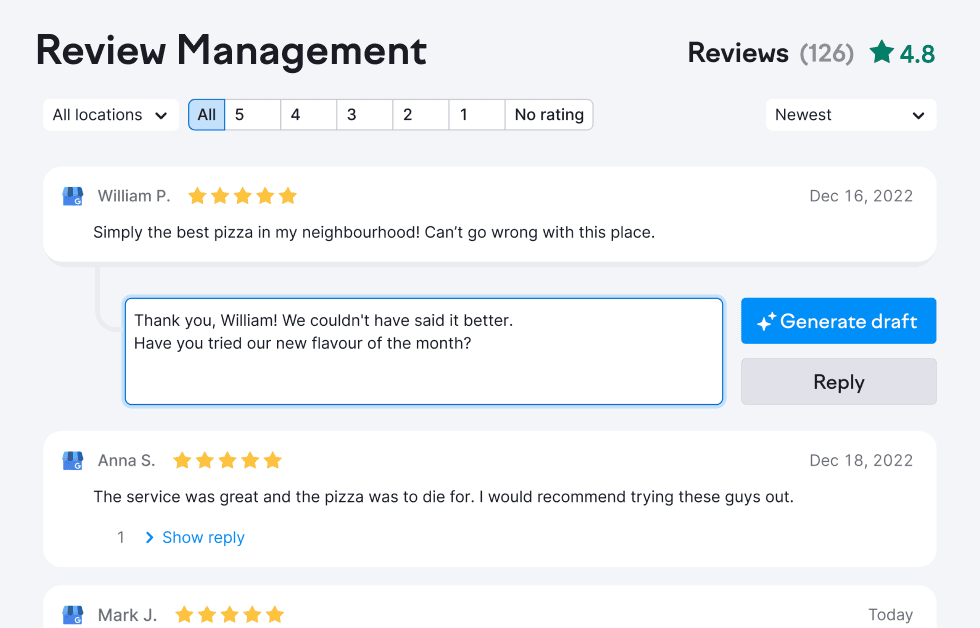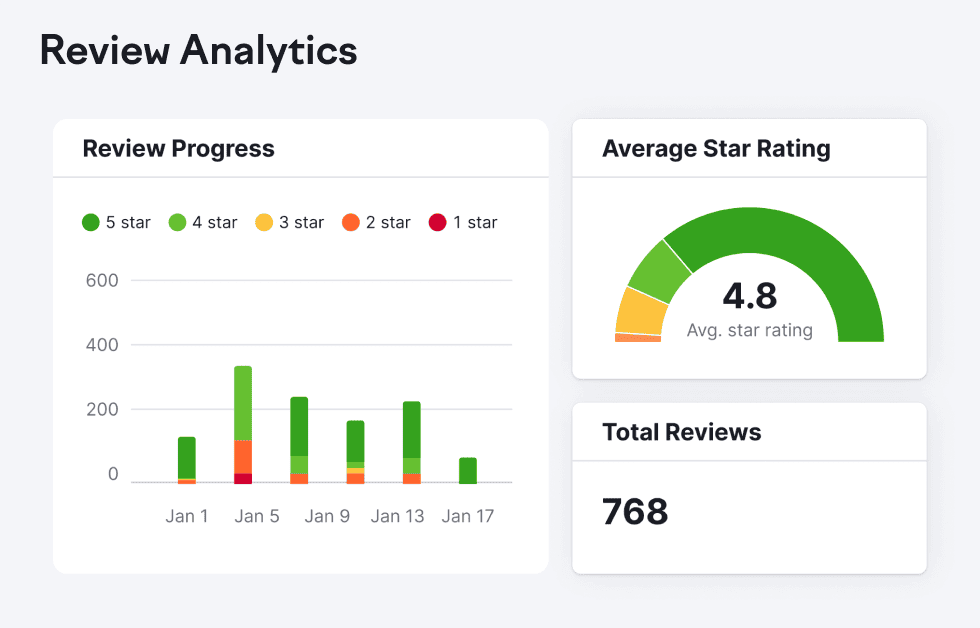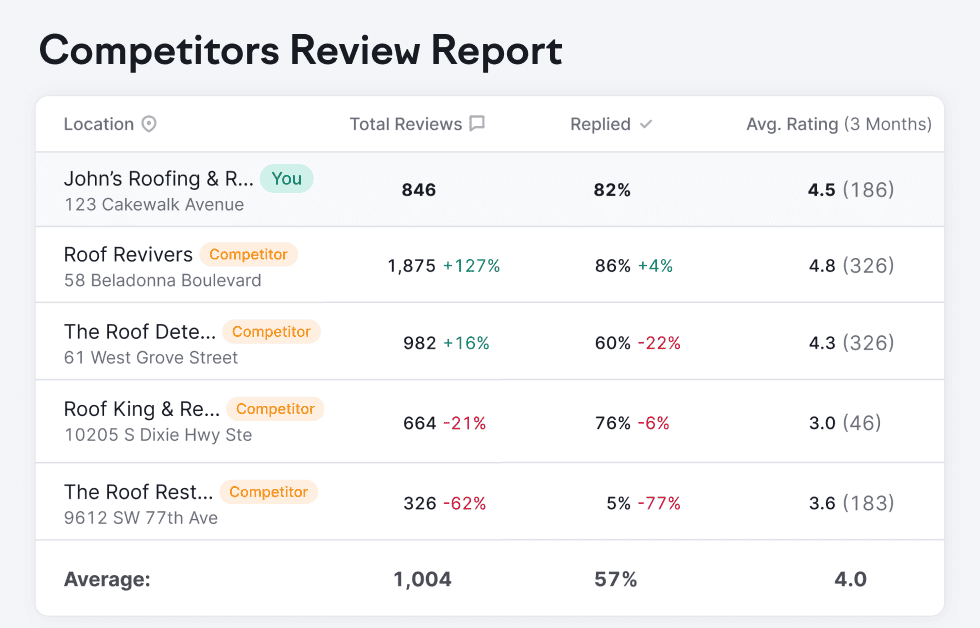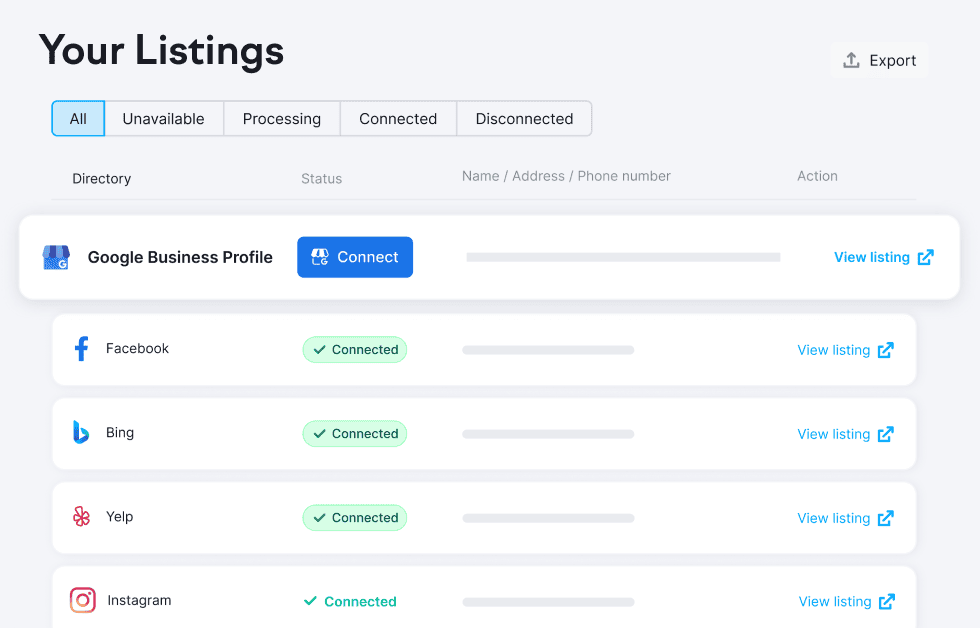- Learning how to ask for reviews is an important part of reputation management and local SEO strategy.
- Choose the best outreach method for your business type and target market for a higher response rate.
- Semrush Local makes review management a lot easier with dedicated tools to streamline your processes.
Understanding how to ask for reviews is the key to building your business’s reputation and rising in local rankings. In an ideal world, every customer who has a good experience with your business would post reviews to your profiles of their own accord. But in reality, people are usually too busy to look up a business online and leave positive feedback. Users rely on reviews to make purchasing decisions, so seeking and managing feedback can dramatically impact your bottom line. That’s why businesses that truly value their reputation know how to ask for a review and build real consumer trust. Asking for reviews doesn’t come easily to every business, so it’s worth considering which method is best. Let’s start with an overview of the benefits of asking for reviews versus leaving it to chance.
Why local businesses must know how to ask for reviews
Asking for reviews plays a pivotal role in shaping a business's reputation. Actively seeking feedback and using review management tools can improve average ratings across multiple review platforms. This gives local businesses more control over how they are perceived online.

A 5 star google review in its interface.
Positive reviews build consumer confidence. When users see others having good experiences, they’re more likely to choose you over competitors that don't ask for reviews. Businesses that actively seek reviews are not only more likely to receive more submissions but also more positive feedback.

Google Local Pack results for “nail salons Upper West Side”
Positive reviews can boost your business's position in local search results, attracting more potential customers. Google takes reviews on its own Business Profile platform and other directories into account for its local business rankings. For example, when users search “nail salons near me”, Google analyzes distance, relevance and prominence to determine positions. And it’s prominence that business owners can influence by asking for reviews.
Reviews also provide valuable insights into customer experiences. Businesses can use this feedback to identify strengths and areas for improvement, ultimately enhancing customer satisfaction.
How to ask for reviews: Tips for best results
The way you ask for a review depends largely on your industry, customer journey and target audience. Email marketing is an effective way to ask for a review post-purchase. You might include a friendly request for feedback with the customer’s invoice or check-in email. If you have your customer’s phone number, an SMS review request can actually be a more effective route. Text messages have a much higher open rate than email; some report it’s as high as 100%.
If you have a physical store, displaying signs asking for reviews can be very effective. Provide QR codes or simple instructions on how to leave a review on popular platforms.

An example of a display sign asking for reviews on a shop entrance
Brick-and-mortar businesses might also set up a physical review box where customers can leave feedback on the spot. Just don’t offer incentives for Google reviews—it’s against the search engine’s policy.
While it won’t benefit local rankings, you could ask customers to let you shoot a quick video review while they’re in-store. If they’re not camera shy, this could be a lot less hassle for them and it adds extra trustworthiness to their review. Leverage your social media platforms by asking for reviews in your posts or stories. You could make attractive designs to highlight your best reviews and encourage your followers to leave their own.

A review posted to a company’s social media page
Encouraging reviews on social media is also great for engaging with customers about their experiences in a public forum. To make it fun, consider asking for reviews in the form of polls or quizzes related to your products or services.
For businesses that work with customers face to face, a more personal touch may be the most effective way to ask for a review. When dealing with loyal customers, large purchases or service-oriented businesses, a check-in call might be appropriate. Make the conversation about them and how they feel about their purchase before you ask for a review.
| Helping hand: Once you’ve received a review, it’s important to reply and thank the customer (or deal with their complaint). Write thoughtful responses faster with Review Management’s AI writing assistant. |
What to say when you ask for reviews
Once you’ve decided the best method to ask for a review, spend some time working on your copy. Of course, emails require a different approach to texts or social posts, but there are a few things to consider no matter how you ask for a review.
Be personal and friendly
Start your outreach with a warm greeting and use the customer's name if possible. Creating a friendly and personal connection makes the message more inviting. Example: “Hey [customer's name]! We hope you're enjoying [your product/service]. Your thoughts mean a lot to us—do you mind sharing your experience with us?”
Express gratitude
Show appreciation for the customer's support and emphasize the value of their opinion. Gratitude can go a long way to encouraging customers to take the time to leave a review. Example: “Thank you for choosing [your company]. We're grateful for your support! Could you spare a moment to share your thoughts?”
Highlight improvement
Convey that you're always looking to enhance your products or services based on customer feedback. This not only encourages reviews but also emphasizes your commitment to continuous improvement. Example: “We're on a mission to make [your product/service] even better. Your insights can help us achieve that—would you mind leaving a review?”
Make it easy
Provide a direct link to the reviews page to streamline the process for the customer. The easier it is for them to leave a review, the more likely they are to do so. Example: “Click here [insert link] to share your thoughts. It doesn’t take long and is super valuable for helping us make our products and services better for you!”

A Google review link that you can use to ask for reviews
Encourage specific feedback
Ask for reviews on specific aspects of your business. This not only helps you gather targeted insights but also guides customers in their reviews. Example: “We'd love to hear what you think about our new [feature/product]. Please share your thoughts on its usability—every detail helps!”
Express openness to critique
Assure customers that you welcome honest feedback, including any constructive criticism. This can build trust and credibility with your audience: Example: “We value transparency. If there's anything you think we can improve, please let us know. Your honest feedback is incredibly important to us.”
A thoughtful and well-crafted review outreach message can significantly boost your response rate. Personalization, gratitude, and simplicity are key to making your request stand out and encourage customers to share their insights.
Review templates
Below are examples of email and SMS templates you can use to build your message, and adapt to your needs:
How to ask for reviews by Email:
Subject: Your Opinion Matters!
Hi [Customer's Name],
Hope you're well! 🌟 Thanks for choosing [Your Company]—your support is appreciated!
We're on a mission to enhance [Your Product/Service], and we'd love your input. Could you spare a moment to share your thoughts? Your feedback is invaluable.
Click [insert link] to leave a quick review. It's easy and helps us improve for you!
We’re particularly curious about your thoughts on our new [Feature/Product].
We welcome honest feedback, so if there's anything to improve, let us know. Your insights matter!
Thanks for being part of [Your Company]. Looking forward to hearing from you!
Best,
[Your Name]
[Your Title & Company]
How to ask for a review by SMS:
Hi [Customer's Name]! 😊 Share your quick thoughts on [Your Product/Service]—click [insert link]. Your feedback is key! 🌟 What are your thoughts on our [Feature/Product]? Honest feedback appreciated. Thanks! 🚀 - [Your Name] at [Your Company]
How to ask for reviews over the phone
"Hi [Customer's Name], it's [Your Name] from [Your Business]. I just wanted to check in and see how everything went with [the product/service they received]. Was everything to your satisfaction?"
[Pause and listen to their response.]
"I'm so glad to hear that! If you wouldn't mind, could you take a moment to share your experience by leaving us a quick review on Google? It really helps other people learn about [your business/service], and we'd greatly appreciate it. I can send you the link via text or email to make it super easy. Does that sound good?"
How to ask for reviews on your website:
Keep it simple and create a section asking online customers to leave a review. Include links to the profile you want them to leave feedback on (especially important if you have multiple locations).

An example of a website that asks Google reviews
How to ask for reviews the wrong way
Businesses that misunderstand how to ask for a review properly often face serious consequences, especially when violating Google’s policies.
Offering incentives for Google reviews may seem tempting, but it's against the search engine’s rules and could lead to penalties, including removal of reviews or suspension of your Google Business Profile.
Buying reviews from unscrupulous agencies or freelancers also damages credibility, as Google can detect fake reviews, potentially flagging or banning your profile.
Another common mistake is engaging in review gating, where you selectively ask only satisfied customers to leave reviews while discouraging or filtering out negative feedback. This practice can harm your reputation in the long run, as it creates an imbalanced representation of your business that lacks authenticity.
Avoid overly complicated instructions that confuse users or delay them from posting their feedback. Simple, clear requests with minimal friction will encourage more authentic responses.
Finally, don’t be pushy when asking for a review. This can come across as desperate or insincere. Instead, focus on building genuine relationships, and ask for reviews at the right moment.
Semrush Local: The best way to manage reviews and improve search rankings
Simpler review responses





